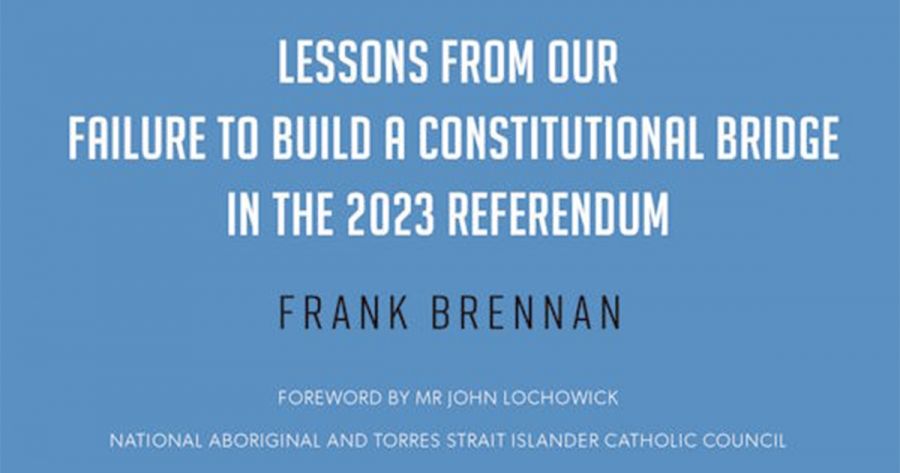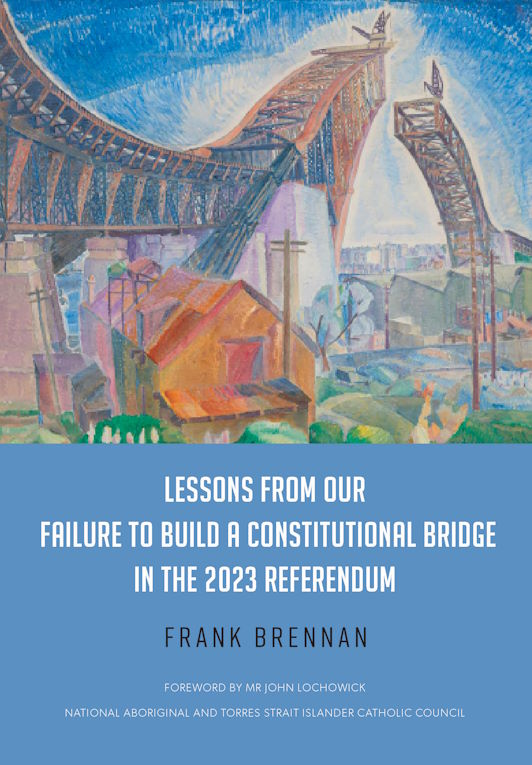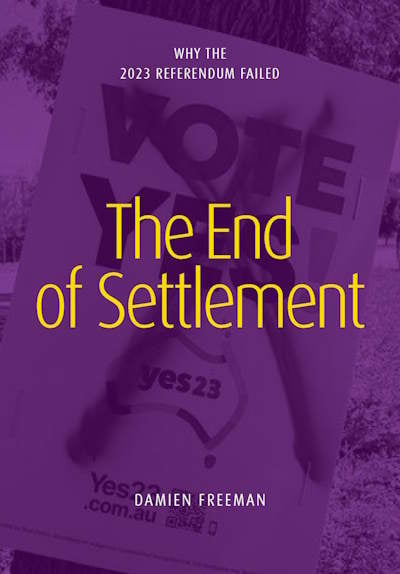
- Free Article: No
- Contents Category: Politics
- Review Article: Yes
- Article Title: Blinkered laments
- Article Subtitle: Two accounts of the Voice referendum
- Online Only: No
- Custom Highlight Text:
It was no surprise, in the end, when the October 2023 referendum on the constitutional enshrinement of an Aboriginal and Torres Strait Islander Voice was comprehensively defeated, given the concerted opposition of the Liberal-National Coalition. The history of Australian referendums is clear: bipartisan support is a necessary precondition for constitutional change.
- Featured Image (400px * 250px):

- Alt Tag (Featured Image): Dominic Kelly reviews ‘Lessons from Our Failure to Build a Constitutional Bridge in the 2023 Referendum’ and ‘The End of Settlement: Why the 2023 referendum failed’
- Book 1 Title: Lessons from Our Failure to Build a Constitutional Bridge in the 2023 Referendum
- Book 1 Biblio: Connor Court Publishing, $24.95 pb, 145 pp
- Book 1 Cover Small (400 x 600):

- Book 1 Cover (800 x 1200):

- Book 2 Title: The End of Settlement
- Book 2 Subtitle: Why the 2023 referendum failed
- Book 2 Biblio: Connor Court Publishing, $24.95 pb, 123 pp
- Book 2 Cover Small (400 x 600):

- Book 2 Cover (800 x 1200):

Brennan, in Lessons from Our Failure to Build a Constitutional Bridge in the 2023 Referendum, is eager to remind his readers that he has been a supporter of Indigenous rights for much of his life. In this, he has strong pedigree: he is the son of the late Gerard Brennan, former Chief Justice of the High Court and lead author of the 1992 Mabo judgment. Brennan, also a lawyer, has published three previous books on Indigenous constitutional recognition, and in 2019 he was appointed to the Coalition government’s Indigenous Voice Co-Design Senior Advisory Group.
Despite this extensive experience in Indigenous affairs, Brennan is at pains to demonstrate his humility and willingness to bow to those with stronger arguments. This is undermined by his insistence on repeating his misgivings about the Voice proposal over and over again. The book itself is mostly previously aired commentary from 2022 and 2023: newspaper columns and other media appearances, homilies, ‘notes on justiciability’, and representations to government and parliament. That is, Brennan is a prominent public figure with a megaphone. It is thus a little hard to swallow the idea that he is merely a humble citizen seeking to be heard amid the din.
Brennan’s central complaint about the referendum process is the lack of bipartisanship, the blame for which he lays squarely on Anthony Albanese. Despite the overwhelming evidence before us that the Coalition was intent on exploiting division and damaging the Labor government by opposing the Voice, Brennan believes that bipartisanship could have been achieved with some tweaks to the process: a constitutional convention in which the views of all Australians could have been heard, and a transparent parliamentary committee process in which Coalition concerns were given more consideration by the government.
The issue that most worried Brennan was the wording of the constitutional amendment. He argues that allowing the Voice to make representations to the Executive Government as well as to the Parliament would have led to a constitutional quagmire. Routine administrative decisions made by a quarter of a million public servants would have been bogged down in litigation, Brennan claims, because Indigenous people, through the Voice, might have argued that they had been inadequately consulted.
The impression given by Brennan’s repeated invocation of ‘routine administrative decisions’ is that junior public servants across the country would have been unable to perform their everyday tasks because of a legal requirement to consult with the Voice. This is fantasy, and it is exposed as such when Brennan finally provides some hypotheticals to support his argument. The first relates to mining approvals in which Indigenous interests might be affected; the second relates to the funding and operation of Indigenous schools in remote communities. Neither could fairly be described as routine administrative matters, and both would likely require a decision by a minister or head of department, rather than by one of the many thousands of non-executive public servants. Furthermore, both should involve departmental consultation with relevant Indigenous communities. It is strange that a supposed supporter of Indigenous rights is so troubled by such a basic level of government accountability.
The broader problem with Brennan’s analysis is that there is no evidence that his process and wording changes would have done anything to persuade Peter Dutton and the Coalition to back the Yes campaign. In this regard, Brennan comes across as hopelessly naïve about the cold reality of adversarial politics. When your political opponents have a strong electoral incentive to exploit and misrepresent your arguments, bipartisanship is unlikely. Combine this with Dutton’s longstanding hostility towards Indigenous rights, and it is a mirage.
The difficulty of achieving bipartisanship in contemporary politics is the main theme of Damien Freeman’s book, The End of Settlement. Freeman is a writer, lawyer, and philosopher who worked closely with Craven, Leeser, Noel Pearson, Shireen Morris, and Anne Twomey to bridge the divide between constitutional conservatives and proponents of substantive Indigenous recognition. As he relates in the book, this group’s discussions contributed to the development of the Voice proposal, so Freeman was naturally deeply invested in the outcome of the referendum.
In considering why the referendum failed, Freeman looks to Australian political history for lessons. Drawing on Paul Kelly’s The End of Certainty (2008), he discusses the virtues of the Deakinite settlement of the early twentieth century, in which politicians with vastly different views came to a general consensus on economic and social policies. He then lauds the bipartisan dismantling of that settlement in the 1980s, when it was seen as being no longer fit for purpose. In contrast with these projects, Freeman now views the Voice referendum as being doomed at the outset because of declining trust in institutions and increasing polarisation. More broadly, he fears that we have reached the end of ‘settlement politics’.
Though fairly innocuous on the surface, there are several problems with Freeman’s argument, beyond his leaden prose. First, he is too wedded to Kelly’s triumphant thesis about bold reformers taking on vested interests and changing Australia for the better in the 1980s. With some wider reading, Freeman might have come to understand polarisation and institutional distrust as stemming from increasing economic inequality, which was unleashed by the very neo-liberal reforms he extols. Such inequality is now entrenched through policies that favour the already wealthy at the expense of the most disadvantaged. None of this seems to be of any interest to Freeman.
Second, Freeman’s notion of settlement politics is conceptually thin, and his fear of its decline seems exaggerated. What he is describing is the standard politics of negotiation and compromise that continues to operate in pluralist democracies, to greater or lesser degrees depending on the issue at hand. Referendums are particularly ill suited to this mode of politics, as the Brexit experience in 2016 so viscerally demonstrated. However, ugly and divisive single-issue political battles in themselves do not suggest a terminal inability to reach compromise.
Finally, Freeman seems blind to the ways in which his virtuous conception of settlement politics may come across very differently to Indigenous people. For them, settlement politics might be better described as status quo politics, in which very little changes. If the past decade and a half of debate about Indigenous constitutional recognition has taught us anything, it is that conservatives remain hostile to substantive change based on the principles of self-determination. An acceptable settlement for the political class – say, symbolic acknowledgment of the special status of First Peoples in the constitution – would have been unacceptable to Indigenous people themselves.
These issues aside, Freeman, unlike Brennan, at least acknowledges the deeply divided political landscape in which the Voice referendum played out. Though he accepts that the Yes campaign made mistakes, he doesn’t share Brennan’s view that bipartisanship could have been achieved with process or wording changes. However, like Brennan, he refrains from criticism of Dutton and other leaders of the No campaign. For both, it was the Yes proponents’ reluctance to compromise that sank the referendum, not the intransigence and hostility of the right.
The notion of conservative goodwill towards Indigenous people is one of the most enduring myths about Indigenous affairs in Australia. Brennan and Freeman perpetuate the fantasy by overstating the significance of limited conservative support for minimal, symbolic change, including from John Howard and Tony Abbott. How the two former prime ministers must have laughed as they enthusiastically joined the No campaign, while still being held up by political naïfs as men of principle.


Comments powered by CComment